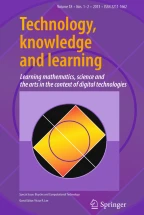616Accesses
30Citations
3Altmetric
Abstract
Our focus is on the design of systems (pedagogical, technical, social) that encourage mathematical abstraction, a process we refer to asdesigning for abstraction. In this paper, we draw on detailed design experiments from our research on children’s understanding about chance and distribution to re-present this work as a case study in designing for abstraction. Through the case study, we elaborate a number of design heuristics that we claim are also identifiable in the broader literature on designing for mathematical abstraction. Our previous work on the micro-evolution of mathematical knowledge indicated that new mathematical abstractions are routinely forged in activity with available tools and representations, coordinated with relatively naïve unstructured knowledge. In this paper, we identify the role of design in steering the micro-evolution of knowledge towards the focus of the designer’s aspirations. A significant finding from the current analysis is the identification of a heuristic in designing for abstraction that requires the intentional blurring of the key mathematical concepts with the tools whose use might foster the construction of that abstraction. It is commonly recognized that meaningful design constructs emerge from careful analysis of children’s activity in relation to the designer’s own framework for mathematical abstraction. The case study in this paper emphasizes the insufficiency of such a model for the relationship between epistemology and design. In fact, the case study characterises the dialectic relationship between epistemological analysis and design, in which the theoretical foundations of designing for abstraction and for the micro-evolution of mathematical knowledge can co-emerge.
This is a preview of subscription content,log in via an institution to check access.
Access this article
Subscribe and save
- Get 10 units per month
- Download Article/Chapter or eBook
- 1 Unit = 1 Article or 1 Chapter
- Cancel anytime
Buy Now
Price includes VAT (Japan)
Instant access to the full article PDF.







Similar content being viewed by others
Explore related subjects
Discover the latest articles, news and stories from top researchers in related subjects.Notes
The version shown here is coded in Imagine Logo (http://www.r-e-m.co.uk/logo/?comp=imagine).
References
Ainley, J., Pratt, D., & Hansen, A. (2006). Connecting engagement and focus in pedagogic task design.British Educational Research Journal,32(1), 21–36.
Cobb, P., Confrey, J., diSessa, A., Lehrer, R., & Schauble, L. (2003). Design experiments in educational research.Educational Researcher,32(1), 9–13.
Collins, A., Joseph, D., & Bielaczyc, K. (2004). Design research: Theoretical and methodological issues.Journal of Learning Sciences,13(1), 15–42.
diSessa, A. A. (1993). Towards an epistemology of physics.Cognition and Instruction,10(2 & 3), 105–226.
Fischbein, E. (1975).The intuitive sources of probabilistic thinking in children: Reidel.
Harel, I., & Papert, S. (1991).Constructionism. Norwood, New Jersey: Ablex.
Kahneman, D., Slovic, P., & Tversky, A. (1982).Judgement under uncertainty: Heuristics and biases. Cambridge: Cambridge University Press.
Konold, C. (1989). Informal conceptions of probability.Cognition and Instruction,6, 59–98.
Lecoutre, M. P. (1992). Cognitive models and problem spaces in “purely random” situations.Educational Studies in Mathematics,23, 589–593.
Noss, R., Healy, L., & Hoyles, C. (1997). The construction of mathematical meanings: Connecting the visual with the symbolic.Educational Studies in Mathematics,33, 203–233.
Noss, R., & Hoyles, C. (1996).Windows on mathematical meanings: Learning cultures and computers. London: Kluwer Academic Publishers.
Papert, S. (1996). An exploration in the space of mathematics educations.International Journal of Computers for Mathematical Learning,1(1), 95–123.
Piaget, J. (1963).The psychology of intelligence. New York: Routledge.
Pratt, D. (2000). Making sense of the total of two dice.Journal for Research in Mathematics Education, 31(5), 602–625.
Pratt, D., & Noss, R. (2002). The micro-evolution of mathematical knowledge: The case of randomness.Journal of the Learning Sciences,11(4), 453–488.
Smith, J. P., diSessa, A. A., & Rochelle, J. (1993). Misconceptions reconceived—a constructivist analysis of knowledge in transition.Journal of Learning Sciences,3(2), 115–163.
Wilensky, U. (1993).Connected mathematics—building concrete relationships with mathematical knowledge. PhD Thesis, Massachusetts Institute of Technology.
Yerushalmy, M. (1999). Making exploration visible: On software design and school algebra curriculum.International Journal of Computers for Mathematical Learning,4(2–3), 169–189.
Author information
Authors and Affiliations
Institute of Education, University of London, 20 Bedford Way, London, WC1H 0AL, UK
Dave Pratt
London Knowledge Lab, Institute of Education, University of London, 23-29 Emerald St, London, WC1N 3QS, UK
Richard Noss
- Dave Pratt
You can also search for this author inPubMed Google Scholar
- Richard Noss
You can also search for this author inPubMed Google Scholar
Corresponding author
Correspondence toDave Pratt.
Rights and permissions
About this article
Cite this article
Pratt, D., Noss, R. Designing for Mathematical Abstraction.Int J Comput Math Learning15, 81–97 (2010). https://doi.org/10.1007/s10758-010-9160-z
Published:
Issue Date:
Share this article
Anyone you share the following link with will be able to read this content:
Sorry, a shareable link is not currently available for this article.
Provided by the Springer Nature SharedIt content-sharing initiative

